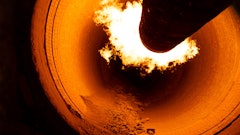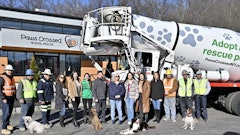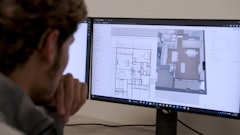
Elementary school children in Lake Mills, WI, are heading back to school this fall with a little more pep in their step. Kindergarten through fourth grade students will have a brand new school with a staff that is the first in the world to be 100% credentialed as Green Classroom Professionals. The school is also aiming for a Silver level of LEED certification as it pilots the new LEED for Schools v4 Beta program.
This isn’t the first sustainable school for the Lake Mills Area School District. In 2011, the Lake Mills Middle School became the first public K-12 school in the world to earn LEED Platinum certification, scoring 58 out of 80 possible points using the LEED for Schools v2007 green building rating system. As a result, the school district is seen by many as a leader in the U.S. in high performance and healthy school buildings.
This fall, the district opened the doors to its newest sustainable-focused school, Lake Mills Elementary. Unlike the middle school, which underwent extensive renovation and expansion, the elementary school is a brand new facility that replaces the original 1954 Prospect Elementary School, which has been deconstructed.
“Lake Mills is a small city with a strong sense of community, conservative values and appreciation for the environment that supports the diverse academic needs of students,” says Theresa Lehman, director of sustainability services, Miron Construction Co. Inc. The Neenah, WI-based construction firm provided pre-construction, construction services and LEED project administration of the 93,284-sq.-ft., two-story elementary school, designed in partnership with Eppstein Uhen Architects (EAU), Milwaukee, WI, to serve up to 600 students and 70 staff.
“When it came time to update the community’s overcrowded and aging elementary school, the demonstrated triple bottom-line success of the middle school was a natural lead-in to the community and district requesting the new elementary school be ‘green,’ as well,” says Lehman. “The project team was challenged by the school board with ‘Are you able to make this greener than the middle school?’ Through the design/build delivery process, the team was able to collaboratively integrate the much more stringent LEED v4 requirements and we were able to do it.
“The delivery process must be an integrative approach that engages all stakeholders and clearly identifies the project drivers and sustainable goals at the onset of the project,” she continues. “By thinking holistically about a building project from the very beginning, and making decisions that add value to the drivers and goals, a true, integrative approach will yield a multitude of benefits.”
A Common Goal
The Miron/EUA project team worked closely with the school district and community to develop project drivers for the $17 million school. These included academic excellence, school/community relationship, cost-effective/practical solutions, security and safety, sustainability and improved environment/aesthetics.
“We identified the initial capital cost and long-term operational costs of every project feature and determined if the idea/item/system/equipment added value to or supported the project drivers,” Lehman says. If it failed to add value or support project drivers, the feature wasn’t included in the scope of the project.
The project’s stated purpose was to facilitate 21st century learning and the mission of “providing an outstanding education and inspiring students to be responsible citizens with integrity.” “We always kept the purpose of the building at the forefront of planning, design and construction,” Lehman states. “All spaces within the school needed to functionally support the mission and purpose.”
LEED v4 Beta Program
The school project was chosen by the USGBC to pilot the LEED v4 Beta Program. LEED for Schools addresses design and construction activities for new school buildings and major renovations of existing structures. It recognizes the unique nature of K-12 school design and construction and addresses issues such as classroom acoustics, daylight and views, mold prevention and environmental site assessment not addressed under other LEED rating systems.
The school district’s objective wasn’t to seek a specific LEED certification award level. Rather, it was to integrate the sustainable goals established and participate as a pilot project in the LEED v4 Program, which significantly raises the bar from the 2009 version. Like v2009, LEED for Schools v4 is based on 110 points. However, it includes two new credit categories: Integrative Process and Location & Transportation.
“As one of only 122 projects piloting LEED v4 world wide, we have the opportunity to make changes to the requirements and/or create alternative compliance paths. We are given the opportunity to sit down with the USGBC and explain how we think the project is meeting the intent of the prerequisites/credits, but doesn’t necessarily comply with the requirements,” says Lehman.
For example, the Sustainable Sites Heat Island Effect Roof credit in previous LEED versions required buildings with low-sloped (flat) roofs to have a solar reflectance index of 78 or greater on 75% of the roof surface. “By participating in the LEED v4 Beta Program, we were able to explain to the USGBC that in Wisconsin, we heat nine months of the year and only cool three months of the year,” says Lehman. “The energy modeler was able to demonstrate that by changing the color of the roofing material to gray (in lieu of white), the elementary school consumed less energy. The USGBC accepted our strategy and, as a result, we no longer have to choose between energy savings or earning a point. It’s a win-win.”
The new school features a high-performance building envelope and energy efficient systems and equipment, including: a geothermal heating and cooling system; natural daylighting with daylight sensors; operable windows; low-flow plumbing fixtures; low-emitting building materials; an eco-screen for environmental education purposes displayed on all of the smartboards in the classrooms plus an interactive screen in the lobby; bioswale; restored native vegetation areas; vegetated roof; solar thermal hot water; and 10-kW photovoltaic system.
“Being a guinea pig isn’t always easy, especially when the industry lags behind,” says Lehman, referring to the new Material & Resource credits. “We definitely had our moments of frustration, and piloting the Beta Program was not exactly what I would call a walk in the park. But what did make the experience so positive is... the perfect storm of a client who understood the benefits that result from a sustainable school coupled with a passionate and enthusiastic project team and an energetic staff who really wanted to use the school to enhance their teaching and create a high-performance, healthy, 21st century learning environment. The team is honored to be a part of the USGBC’s LEED v4 Beta Program and we hope our contributions of practicality will benefit future LEED projects around the world.”

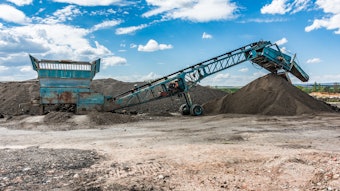
![Img 1707[56]](https://img.forconstructionpros.com/files/base/acbm/fcp/image/2023/04/IMG_1707_56_.6437076c97961.png?auto=format%2Ccompress&fit=crop&h=191&q=70&rect=0%2C462%2C1920%2C1080&w=340)










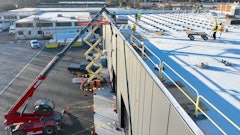
![Glp Porsche 072723 465 64ee42287c29e[1]](https://img.forconstructionpros.com/files/base/acbm/fcp/image/2024/03/GLP_PORSCHE_072723_465.64ee42287c29e_1_.65e88b8589b9c.png?auto=format%2Ccompress&fit=crop&h=135&q=70&rect=0%2C520%2C2250%2C1266&w=240)

